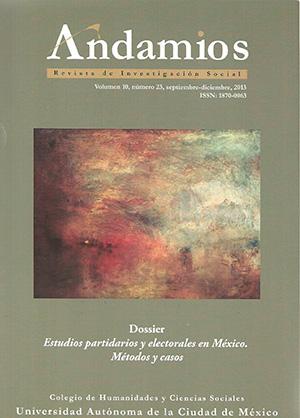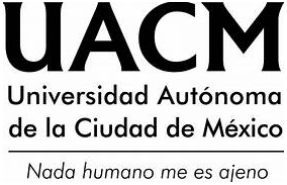Una teoría sobre el comportamiento de los partidos políticos competitivos
DOI:
https://doi.org/10.29092/uacm.v10i23.252Resumen
No AplicaDescargas
Citas
Aldrich, J. H. (1983a), “A Downsian Spatial Model with Party Activism”, en American Political Science Review, núm. 77, Texas: UNT. p. 974-990.
——— (1983b), “A spatial model with party activists: Implications for electoral dynamics”, en Public Cltoice, núm. 41 Holanda: Martinus Nijhoff Publishers. p. 63-100.
Austen-Smith, D. y Banks, J. (1988), “Elections, Coalitions, and Legislative Outcomes”, en American Political Science Review, núm. 82 Texas: UNT. p. 405-422.
Axelrod, R. (1970), Conflict of Interest, Chicago: Markham.
Banzhaf, J. (1965), “Weighted Voting doesn’t Work: a Mathematical Analysis”, en Rutgers Law Review, núm. 19 Estados Unidos. p. 317-343.
Barry, B. (1970), Sociologists, Economists, and Democracy, Chicago: University of Chicago Press.
Bogdanor, V. y Buder, D. (eds.), (1983), Democracy and Elections, Cambridge: Cambridge University Press.
Browne, E. (1973), Coalition Theories: A Logical and Empirical Critique, Beverly Hills: Sage.
Budge, I. y Laver, M. (1986), “Office Seeking and Policy Pursuit in Coalition Theory”, en Legislative Studies Quarterly, núm. 11. p. 485-506.
Budge, I., Robertson, D. y Hearl, D. (eds.), (1987), Ideology, Strategy, and Party Change: Spatial Analyses of Post-War Election Programmes in 19 Democracies, Cambridge: Cambridge University Press.
Bueno de Mesquita, B. (1975), Strategy, Risk and Personality in CoalitionPolitics. The case of India. Cambridge: Cambridge University Press.
Calvert, L. (1987), “Reputation and legislative leadership”, en Public Choice, núm. 55. p. 81-119.
Carstairs, A. (1980), A Short History of Electoral Systems in Western Europe, Londres: Allen and Unwin.
Castles, F. y Wildenmann, R. (eds.), (1986), Visions and Realities of Party Government, Berlin: Walter de Gruyter.
Chappell, W. y Keech, W. (1986), “Policy Motivation and Party Differences in a Dynamic Spatial Model of Party Competition”, en American Political Science Review, núm. 80. p. 881-899.
Clark, P. y Wilson, J. (1961), “Incentive Systems: a Theory of Organizations”, en Administrative science Quarterly, núm. 6. p.129-166.
Cotter, C., Gibson, J., Bibby, J. y Hucksbom, R. (1984), Party Organization in American Politics, Nueva York: Praeger.
Cyert, R. y March, J. (1963), A Behavioral Theory of the Firm, Nueva Jersey: Prentice-Hall.
De Felice, G. (1981), “Separating Professionalism from Pragmatism. A Research Note on the Study of Political Parties”, en American Journal of Political Science, núm. 25. p. 796-807.
De Swaan, A. (1973), Coalition Theories and Cabinet Formation, Amsterdam: Elsevier.
Downs, A. (1957), A Economic Theory of Democracy, Nueva York: Harper and Row.
Duverger, M. (1954), Political Parties, Londres: Methuen.
Enelow, J. y Hinich, M. (1984), The Spatial Theory of Voting: an Introduction, Cambridge: Cambridge University Press.
Epstein, L. (1967), Political Parties in Western Democracies, Nueva York: Praeger.
Fiorina, M. (1981), Retrospective Voting in American National Elections, Nuevo Haven: Yale University Press.
Frohlich, N., Oppenheimer, J. y Young, O. (1971), Political Leadership and Collective Goods, Princeton: Princeton University Press.
Greenberg, J. y Shepsle, K. (1987), “The Effect of Electoral Rewards in Multiparty Competition With Entry”, en American Political Science Review, núm. 81. p. 525-537.
Grofrnan, B. y Lijphart, A. (eds.), (1986), Electoral Laws and Their Political Consequences, Nueva York: Agathon.
Hansson, I. y Stuart, C. (1984), “Voting Competitions With Interest Politicians: Platforms do not Converge to the Preferences of the Median Voter”, en Public Choice, núm. 44. p. 431-441.
Harmel, R. y Janda, K. (1982), Parties and Their Environments: Limits to Reform? Nueva York: Longman.
Hinich, M. y Ordeshook, P. (1970), “Plurality Maximization vs. Vote Maximization: a Spatial Analysis With Variable Participation”, en American Political Science Review, núm. 64. p. 772-791.
Hofstett er, R. (1971), “The Amateur Politician: a Problem in Construct Validation”, en Midwest Journal of Political Science, núm. 15. p. 31-56.
Holler, M. (ed.), (1982), Power. Voting and Voting Power. Wilnburg: Physica-Verlag.
Holmstrom, B. y Tirole, J. (1989), “The Theory of the Firm”, en Richard Schmalensee y Robert D. Willig, (eds.), Handbook of Industrial Orgabization, Amsterdam: North-Holland. p. 61-133.
Janda, K. (1980), Political Parties: a Cross-National Survey, Nueva York: Free Press.
Katz, R. (1986), “Party Government: a Rationalistic Conception”, en Francis G. Castles y Rudolf Wildenmann (eds.), Visions and Realities of Party Government, Berlin: Walter de Groyter.
——— (1987), Party Governments: Europe and American Experiences, Berlin: Walter de Gruyter.
Kavanaugh, D. (1985), “Power in British Political Parties: Iron Law or Special Pleading?”, en West European Politics, vol. 8 núm. 3. p. 5-22.
Kirchheimer, O. (1966), “The Transformation of Western European Party Systems”, en Joseph La Palombara y Myron Weiner (eds.), Political Parties and Political Development, Princeton: Princeton University Press.
Kreps, D. (1984), Corporate Culture and Economic Theory, Mimeo. Stanford: Stanford University.
Kvavik, R. (1976), Interest groups in Norwegian Politics, Oslo: Universitetsforlaget.
Laver, M. (1981), The Politics of Private Desires, Harmondsworth: Penguin.
——— (1989), “Party Competition and Party System Change”, en Journal of Theoretical Politics, núm. 1. p. 301-324.
——— (1990), “The ReIationship Between Coalition and Party Policy in Ireland”, en Michael J. Laver y Ian Budge (eds.), Party Policy and Coalition Government in Western Europe.
Laver, M. y Schofield, N. (1990), Multiparty Government: the Politics of Coalition in Europe, Oxford: Oxford University Press.
Laver, M. y Shepsle, K. (1989), “Government Coalitions and Intraparty Politics”, Mimeo. Cambridge: Harvard University.
Lawson, K. (1976), The Comparative Study of Political Parties, Nueva York: St. Martin’s.
Lehmbruch, G. (1967), Proporzdemokratie: Politisches System and Politische Kultur in der Schweiz und in Österreich. Tubinga: Mohr.
Leiserson, M. (1968), “Factions and Coalitions in One-Party Japan”, en American Political Science Review, núm. 62. p. 770- 787.
Lijphart, A. (1977), Democracy in Plural societies, Nuevo Haven: Yale University Press.
——— (1984), Democracies, Nuevo Haven: Yale University Press.
Luebbert, G. (1986), Comparative Democracy: Policy Making and Governing CoaIitons in Europe and Israel, Nueva York: Columbia University Press.
Luther, R. (1989), “Dimensions of Party System Change: The Case of Austria”, en West European Politics, Vol. 12, núm. 4. p. 3-27.
McKenzie, R. (1982), “Power in the Labour Party: the Issue of ‘Intra- Party Democracy’”, en Dennis Kavanaugh (ed.), The Politics of the Labour Party, Londres: Allen and Unwin.
March, J. y Olsen, J. (1984), “The New Institutionalism: Organizational Factors in Political Life”, en American Political Science Review, núm. 78. p. 734-749.
Marradi, A. (1982), “lIaly: from ‘Centrism’ to Crisis of the Center-Left Coalitions”, en Eric C. Browne y John Dreijmanis (eds.), Government Coalitions in Western Democracies, Nueva York: Longman.
Martin, A. (1984), “Trade Unions in Sweden: Strategies and Responses to Change and Crisis”, en Peter Gourevitch, Andrew Martovits, Andrew Martin y George Ross (eds.), Unions and Economic Crisis, Nueva York: Allen and Unwin.
Moe, T. (1984), “The New Economics of Organization”, en American Joumal of Political Science, núm. 28. p. 739-777.
Newman, M. (1987), “Conflict and Cohesion in the British Labour Party and French Communist Party”, en Western European PoIitics, vol. 10, núm. 2. p. 116-92.
Nousiainen, J. (1988), “Bureaucratic Tradition, Semi-Presidential Rule and Parliamentary Government: the Case of Finland”, en European Joumal of Political Research, vol. 16, núm. 2. p. 229-49.
Olsen, J. (1983), Organized democracy, Bergen: Universitetsforlaget.
Ordesbook, P. (1986), Game Theory and Political Theory, Cambridge: Cambridge University Press.
Paltiel, K. (1981), “Campaign Finance: Contrasting Practices and Reforms”, en David Butler, Howard R. Penniman y Austin
Ranney (eds.), Democracy at the Polls, Washington, DC: American Enterprise Institute.
Petry, F. (1982), “Vote-Maximizing Versus Utility-Maximizing Candidates: Comparing-Dynamic Models of Bi-Party Competition”, en QuaIity and Quantity, núm. 16. p. 500-526.
Putnam, R. (1976), The Comparative Study of Political Elites, Englewood Cliffs, Nueva Jersey: Prentice Hall.
Rae, D. (1971), The Political Consequences of Electoral Laws, Nuevo Haven: Yale University Press.
Riker, W. (1962), The Theory of Political Coalitions, Nuevo Haven: Yale University Press.
——— (1982), Liberalism Against Populism: a Confrontation Between the Theory of Democracy and the Theory of Social Choice, San Francisco: Freeman.
——— (1982b), “The Two-Party System and Duverger’s Law: an Essay on the History of Political Science”, en American Political Science Review, núm. 76. p. 753-766.
Robertson, D. (1976), A Theory of Party Competition, Nueva York: Wiley. Rose, R. y Mackie, T. (1983), “Incumbency in Government: Asset or Liability?”, en Hans Daalder y Peter Mair (eds.), Western European Party Systems: Continuity and Change, Beverly Hills: Sage.
Salisbury, R. (1969), “An Exchange Theory of Interest Groups”, en Midwest Journal of Political Science, núm. 13. p. 1-32.
Sartori, G. (1976), Parties and Party Systems, Cambridge: Cambridge University Press.
Schlesinger, J. (1965), “Political Party Organization”, en James G. March (ed.), Handbook of Organizations, Chicago: Rand McNally.
——— (1984), “On the Theory of Party Organization”, en Journal of Politics, núm. 6. p. 369-400.
——— (1985), “The New American Political Party”, American Political Science Review, núm. 79. p. 1152-1169.
Shapley, Ll. y Martin S. (1954), “A Method of Evaluating Power in a Committee System”, en American Political Science Review, núm. 48. p. 787-792.
Shepsle, K. (1979), “Institutional Arrangement and Equilibrium in Multidimensional Voting Models”, en American Journal of Political Science, núm. 23. p. 27-59.
Sjöblom, G. (1968), Party Strategies in a Multiparty System, Lund: Studenditteratur.
Sorauf, F. y Beck, P. (1988), Party Politics in America, Glenview, IL: Scott Foresman.
Soule, J. y Ouke, J. (1970), “Amateurs and Professionals: a Study of Delegates to the 1968 Democratic National Convention”, en American Political Science Review, núm. 64. p. 888-898.
Steel, B. y Tsurutani, T. (1986), “From Consensus to Dissensus: a Note on Postindustrial Political Parties”, en Comparative Politics, núm. 18. p. 235-248.
Stokes, D. (1963), “Spatial Models of Party Competition”, en American Political Science Review, núm. 57. p. 368-391.
Strom, K. (1984), “Minority Governments in Parliamentary Democracies: the Rationality of Non-Winning Cabinet Solutions”, en Comparative Political Studies, núm. 17. p. 199-227.
——— (1985), “Party Goals and Government Performance in Parliamentary Democracies”, en American Political Science Review, núm. 79. p. 738-754.
——— (1990), Minority Government and Majority Rule, Cambridge: Cambridge University Press.
Tsebelis, G. (1988), “Why do Eoglish Labour Party Activists Commit Political Suicide?”, Ponencia presentada en el encuentro anual de la American Political Science Association, Washington, DC.
Von Beyme, K. (1985), Political Parties in Western Democracies, Nueva York: S1. Martin’s.
Weingast, B. y William, J. (1988), “The Industrial Organization of Congress; or, why Legislatures, Like Firms, are not Organized as Markets”, en Journal of Political Economy, núm. 96. p. 132-163.
Wilson, J. (1962), The Amateur Democrat, Chicago: University of Chicago Press.
——— (1973), Political Organizations, Nueva York: Basic Books.
Wittman, D. (1973), “Parties as Utility Maximizers”, en American Political Science Review, núm. 67. p. 490-498.
——— (1983), “Candidate Motivation: a Synthesis of Alternative Theories”, en American Political Science Review, núm. 77. p.142-157.
Publicado
Número
Sección
Licencia
Esta revista está bajo una licencia Creative Commons México 2.5. Está permitida la reproducción y difusión de los contenidos de la revista para fines educativos o de investigación, sin ánimo de lucro, siempre y cuando éstos no se mutilen, y se cite la procedencia (Andamios, Revista de Investigación Social) y al autor. Los derechos patrimoniales de los artículos publicados en Andamios, Revista de Investigación Social son cedidos por el(los) autor(es) a la Universidad Autónoma de la Ciudad de México una vez que los originales han sido aceptados para que se publiquen y distribuyan tanto en la versión impresa como electrónica de la revista. Sin embargo, tal y como lo establece la ley, el(los) autor(es) conserva(n) sus derechos morales. El(los) autor(es) recibirá(n) una forma de cesión de derechos patrimoniales que deberá(n) firmar una vez que su original haya sido aceptado. En el caso de trabajos colectivos bastará la firma de uno de los autores, en el entendido de que éste ha obtenido el consentimiento de los demás. Los autores podrán usar el material de su artículo en otros trabajos o libros publicados por ellos mismos, con la condición de citar a Andamios como la fuente original de los textos.


